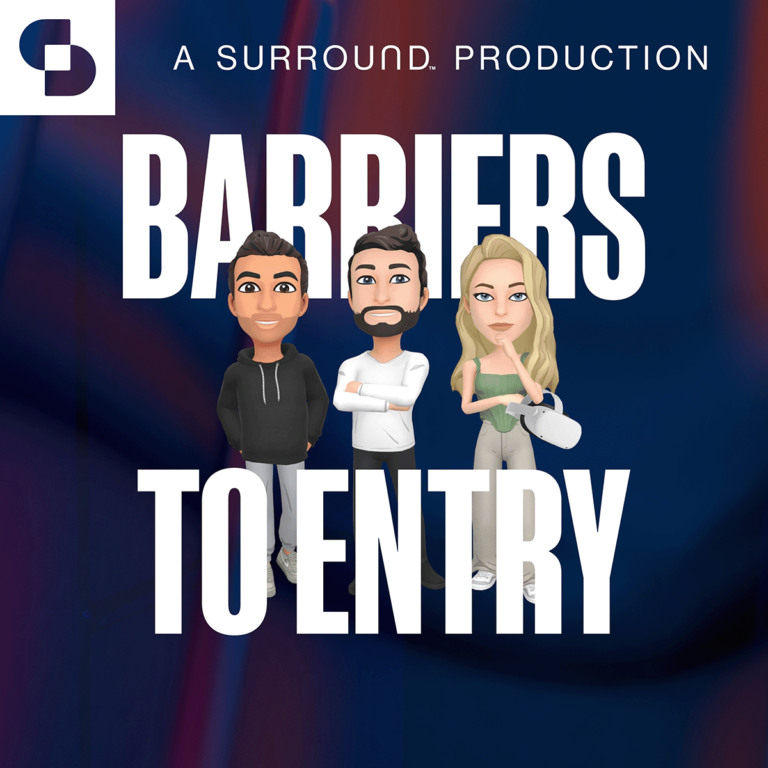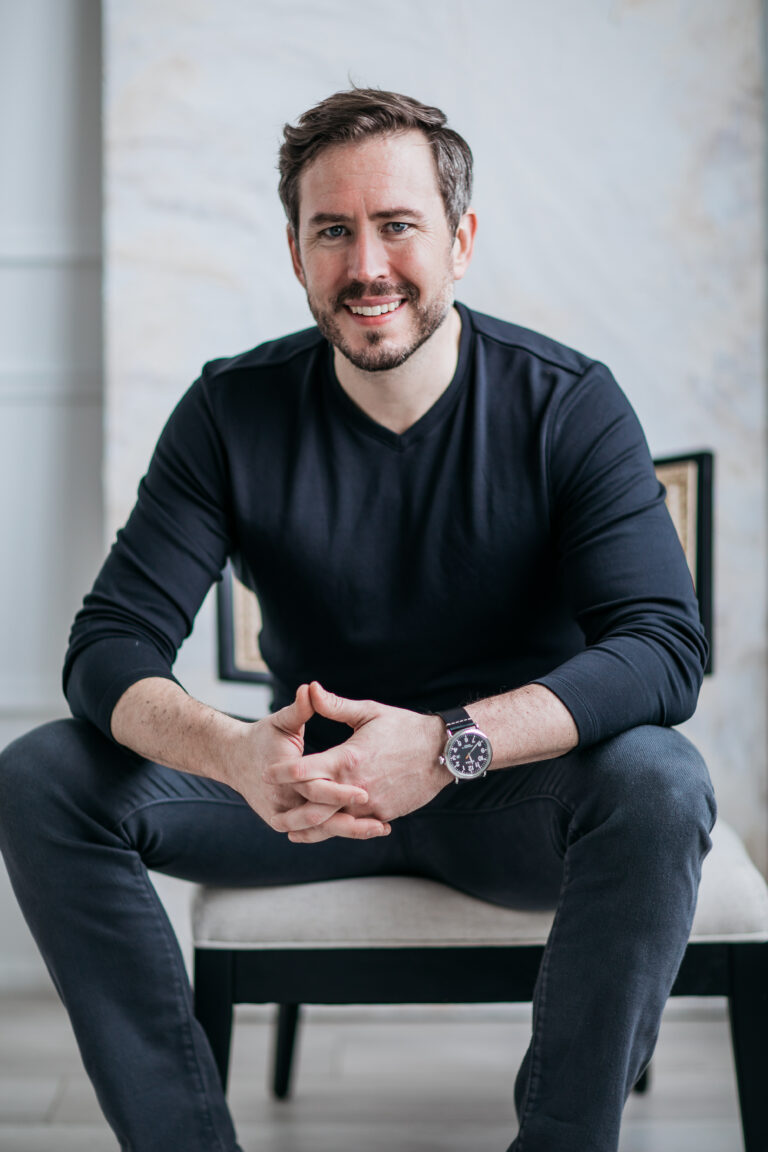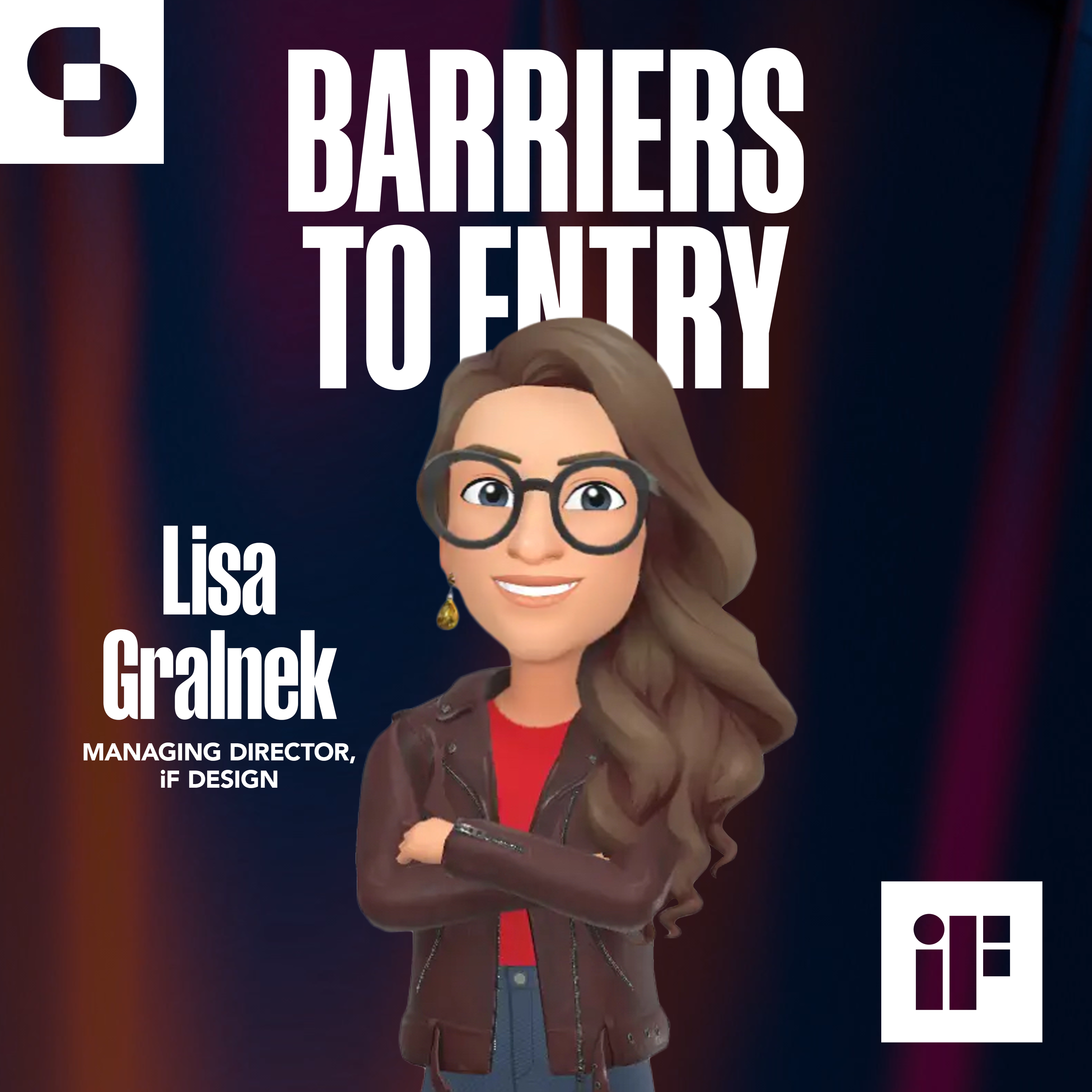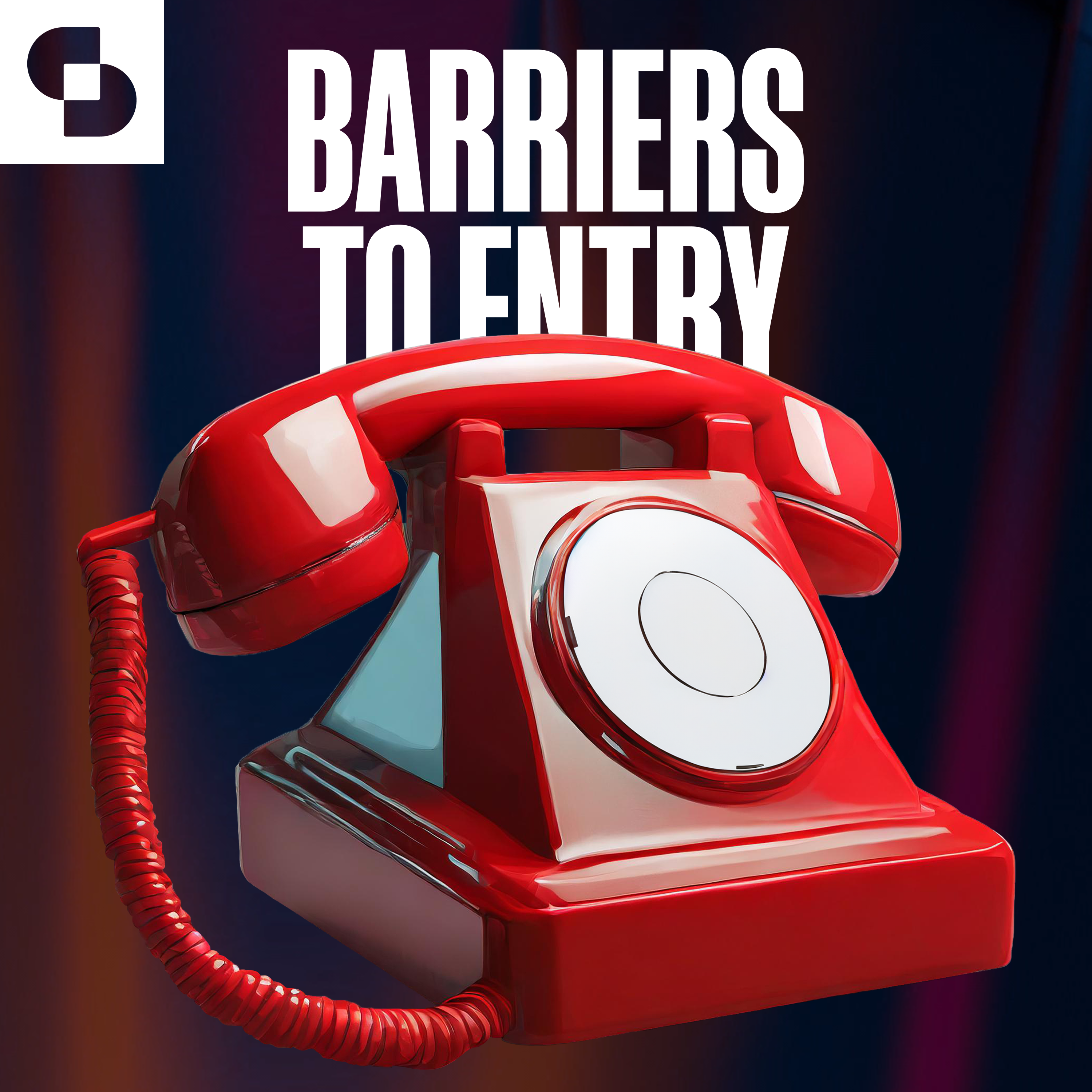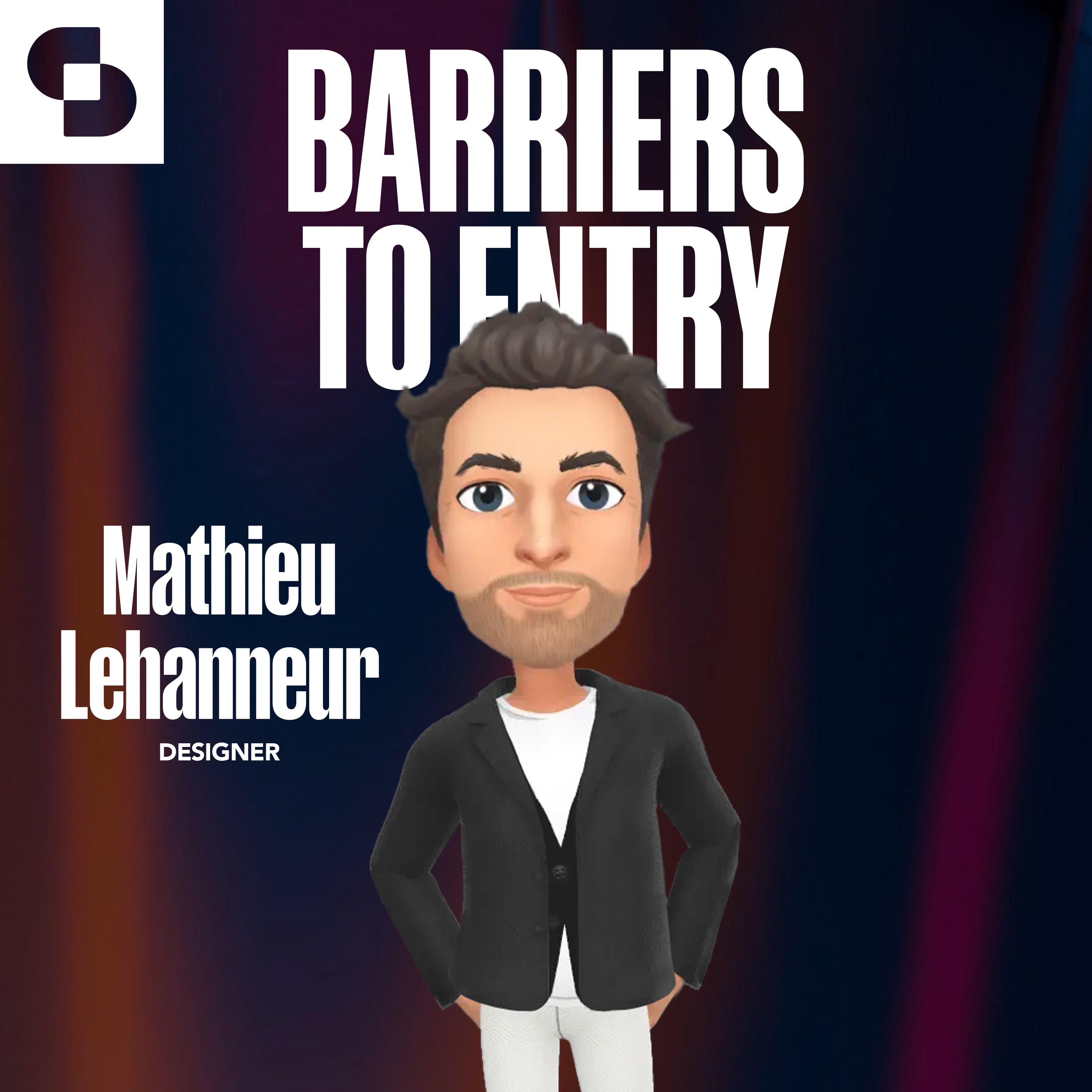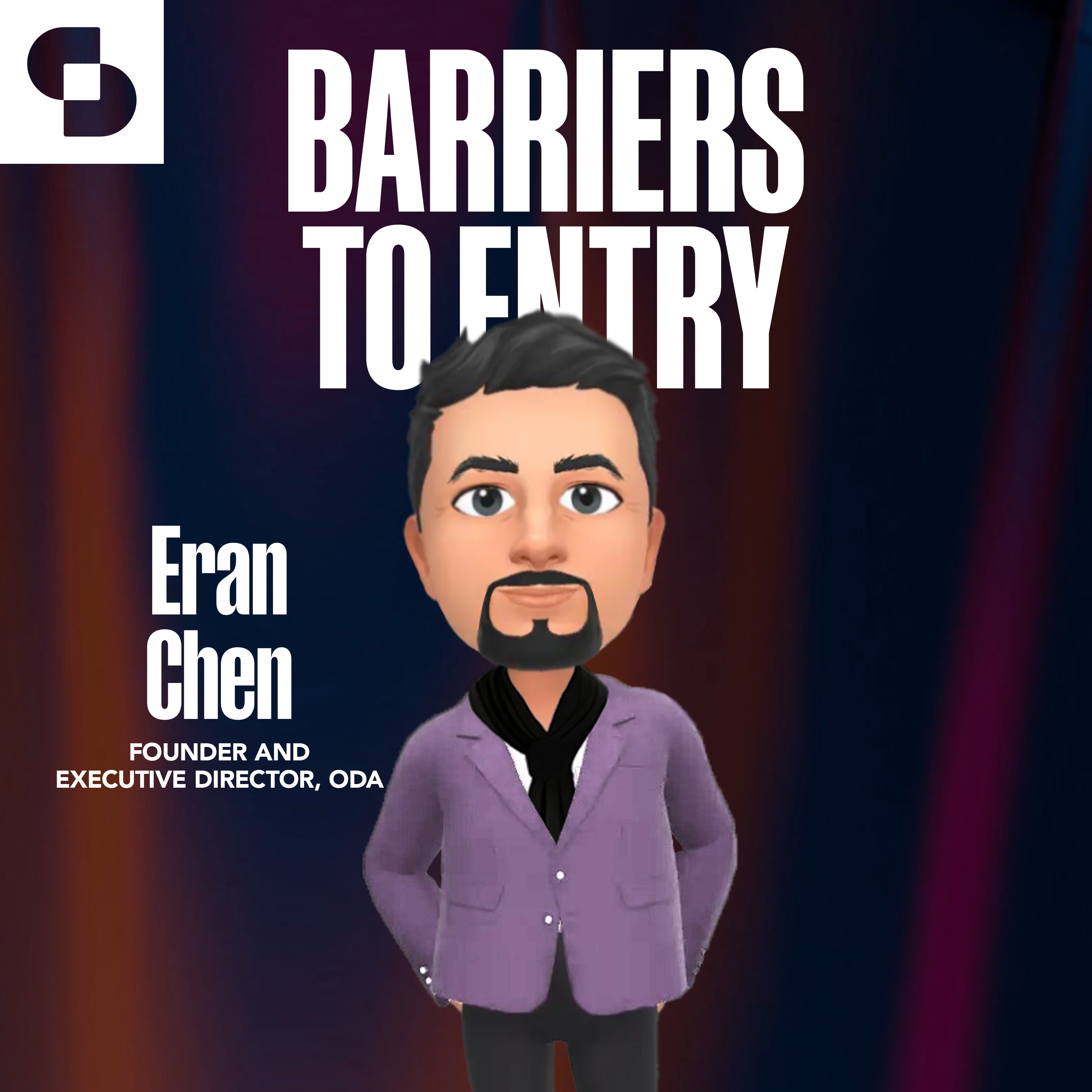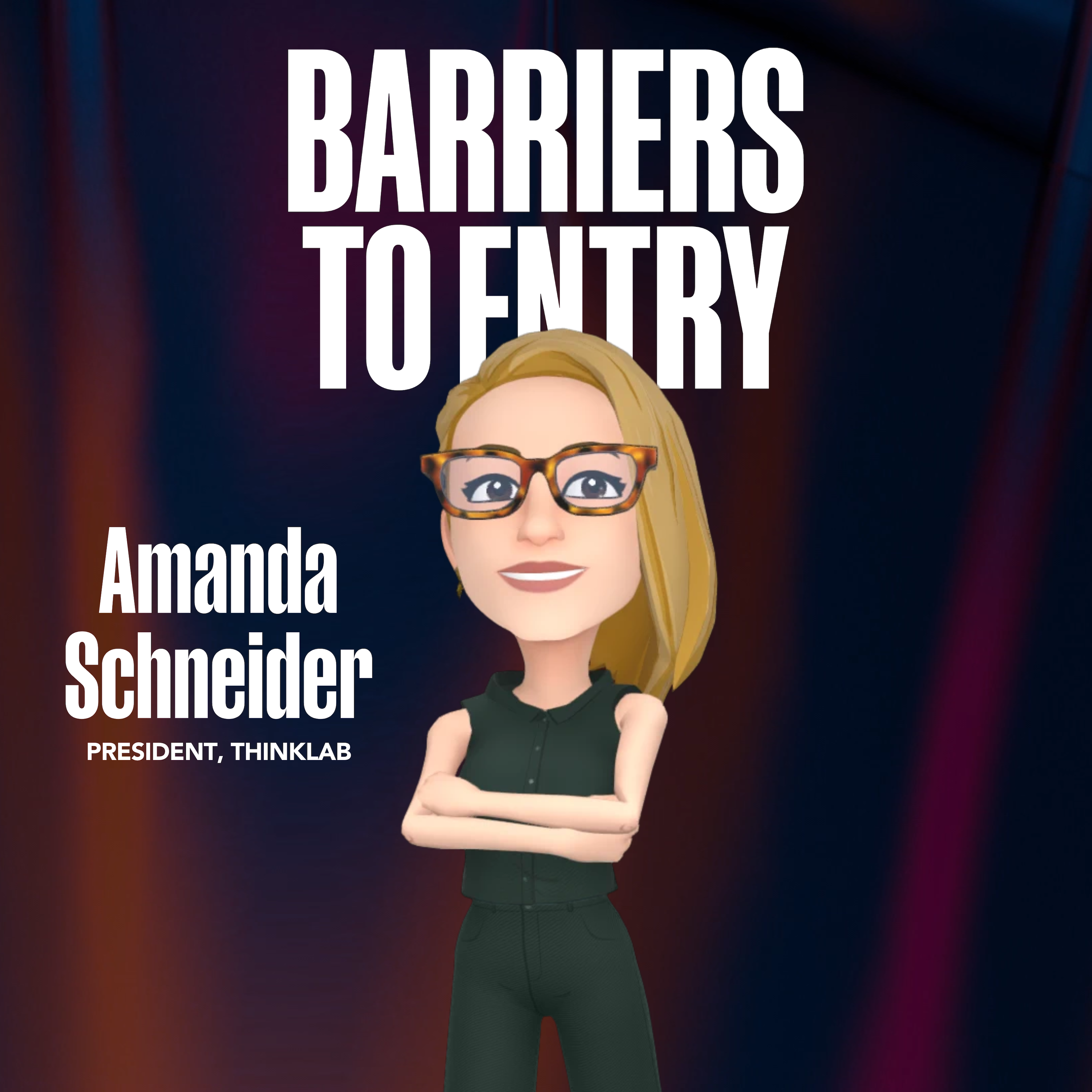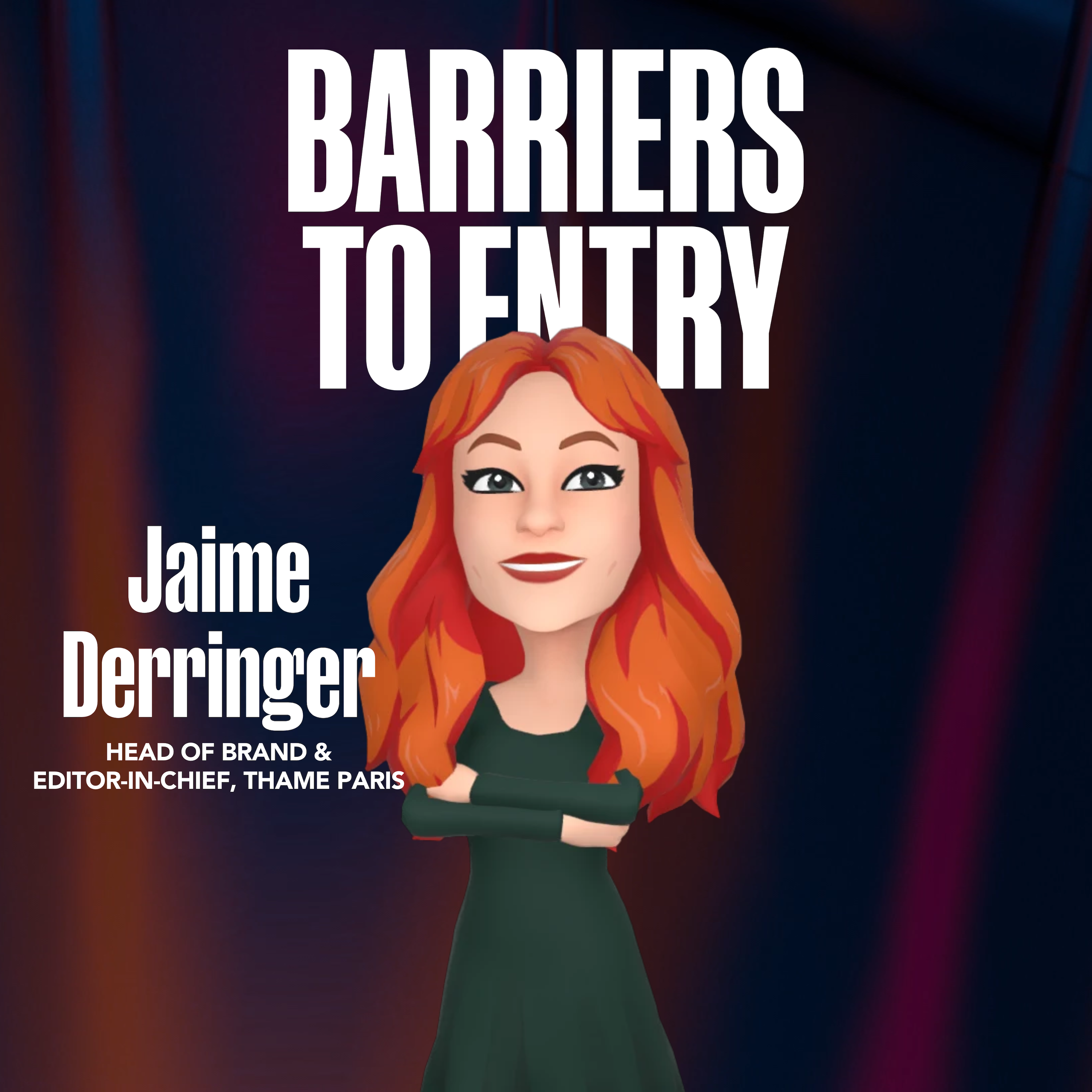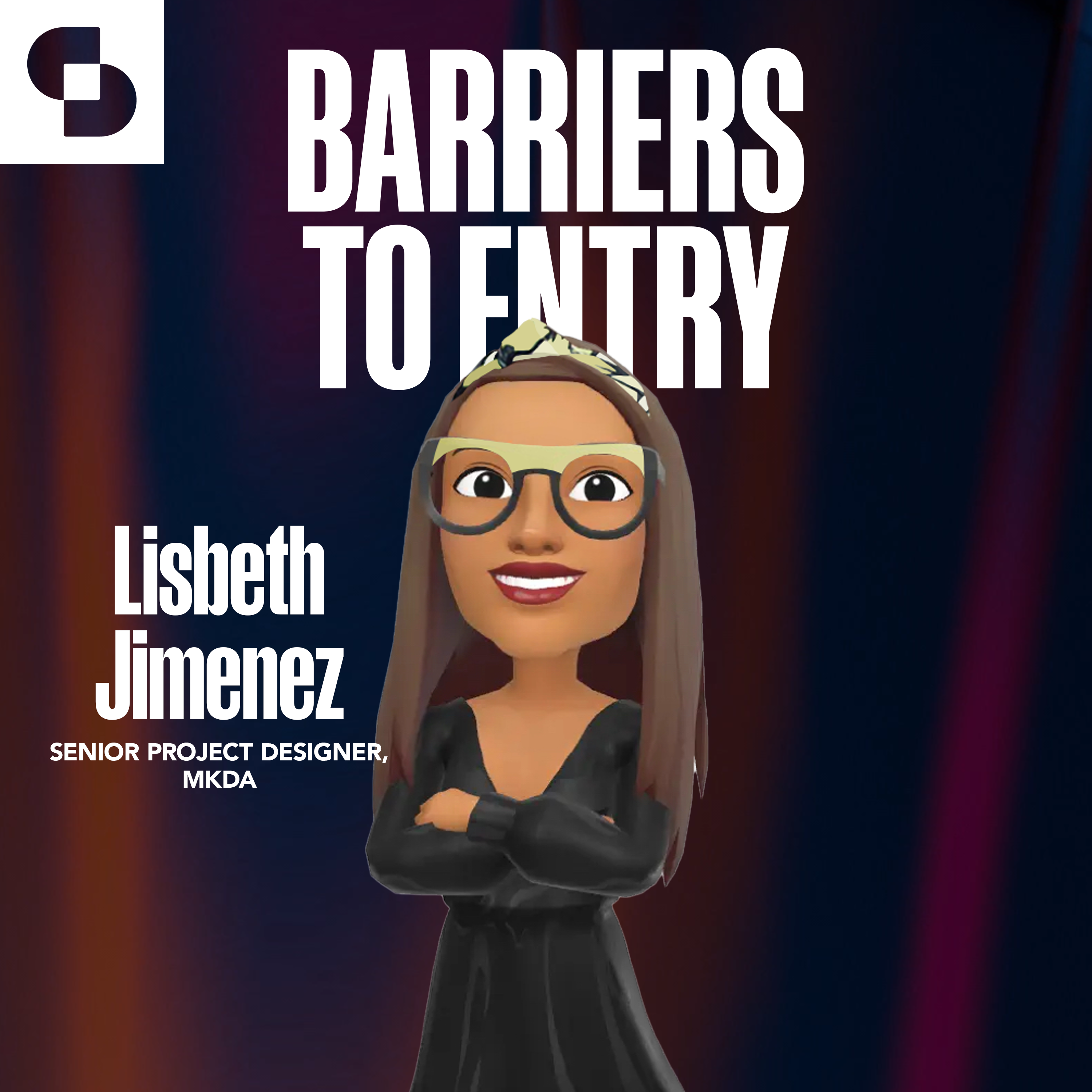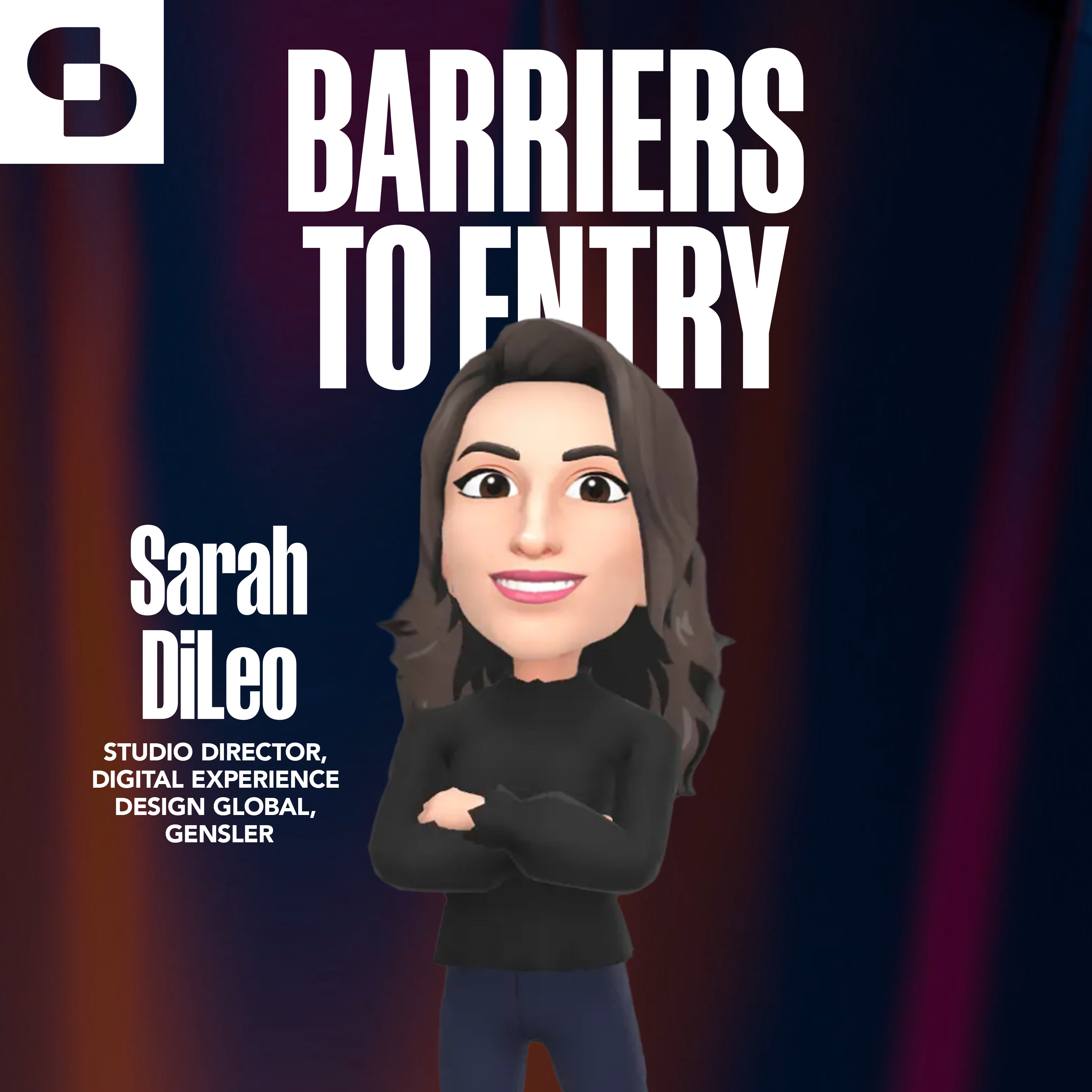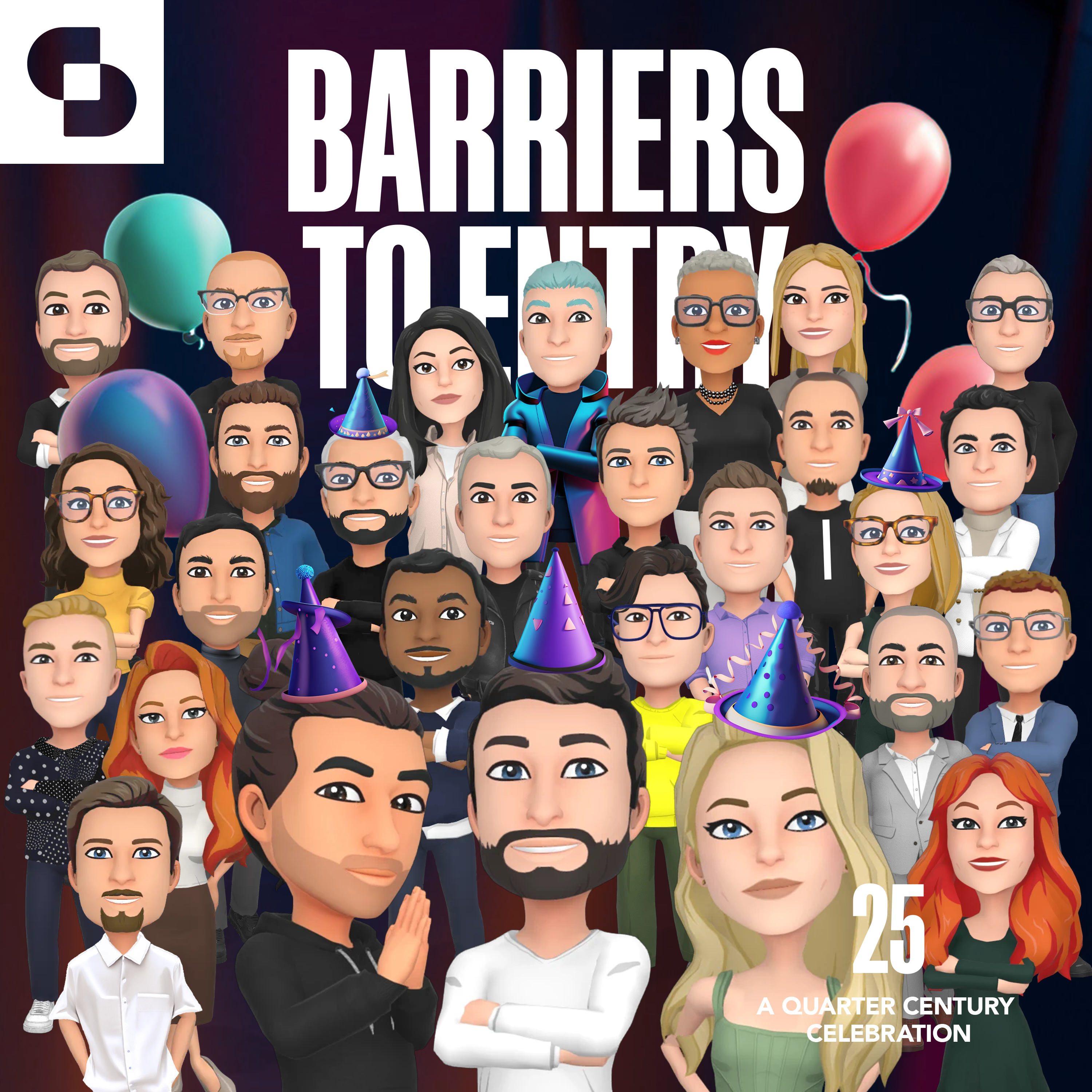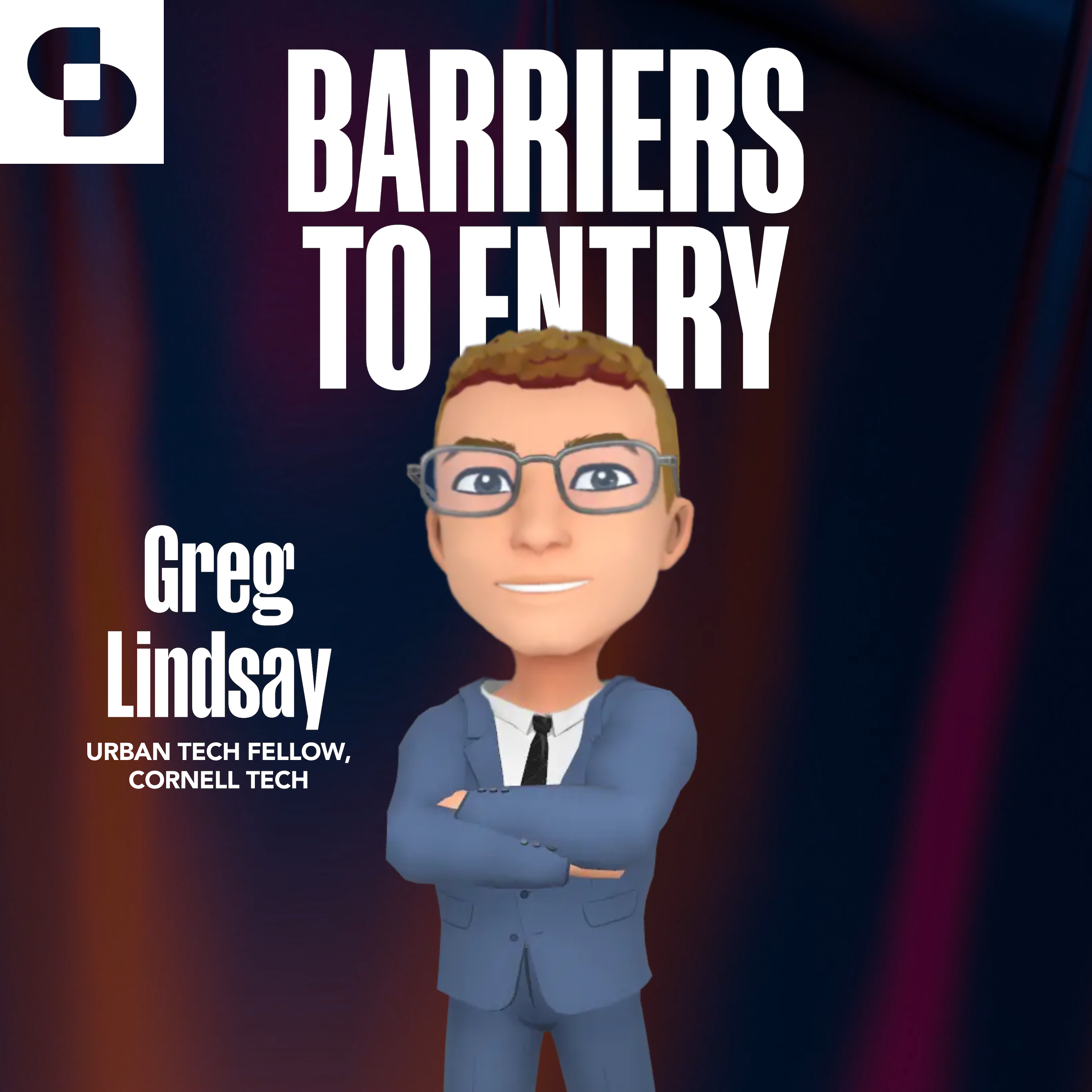On the latest episode of Barriers to Entry, we sit down with an early leader at one of the most publicized and possibly most criticized of the ‘metaverse’ worlds, Decentaland. Sam Hamilton came to the Decentraland Foundation through a journey stemming from art and music that intersected with technology in the early days of the rise of cryptocurrency and NFTs. Today, he oversees the direction of a digital world that has made global headlines with its Metaverse Fashion Week but is still largely misunderstood.
Listen in as the pod squad dives deeper to understand the intricacies of how Decentraland operates, its goals to democratize and create a more human internet, and the tools and governance that its created in order to allow design, creativity, and autonomy to flourish.
Connect with Sam Hamilton on LinkedIn!
Moments to check out:
- Creating a platform to allow independent creators to thrive (starting at 12:30)
- The Decentraland visual aesthetic and the opportunities to evolve how we interact with the internet (starting at 18:39)
- Bringing an architects’ mindset to world building (starting at 24:23)
- Learning from Metaverse Fashion Week and the role of Artificial Intelligence moving forward (starting at 35:43)
Connect with our hosts on LinkedIn;
References and resources:
Discover more shows from SURROUND at surroundpodcasts.com. This episode of Barriers to Entry was produced and edited by SANDOW Design Group. Special thanks to the podcast production team: Hannah Viti, Wize Grazette, Kasey Campbell Thompson, Rob Schulte, and Samantha Sager.
Sam Hamilton: [00:00:00] In the metaverse, if that’s the word we’re gonna use. Like in some ways we already live in this like digital realm. We’re spending so much time there anyway, that this next iteration of that, which is a 3D spatial version, is a much more human experience and therefore we shall really play with those emotions. We’re not just looking at flat texts and pictures on the screen. We’re actually immersed inside a world where you can do human things.
Tessa Bain: Hello everybody! Welcome to Barriers to Entry, the podcast where every episode we get into it with the leaders, the designers, the early adopters, and the influencers who are helping to shape innovation in the metaverse, artificial intelligence, the blockchain and more, and what that’s gonna mean for the architecture and design industry.
I’m Tessa Bain, and as always, I am joined by my very excitable co-host. Andrew Lane and Bobby Bonnet.
Andrew Lane: I appreciate that. I’d like to be easily excited and we’ve got an exciting guest today. It’s [00:01:00] exciting the way we’re seeing the industry evolving and the opportunity to, to talk about that with the audience and with all of you is really exciting.
I, I noticed, and Bobby, I know you wanted to jump in on this, but. We added AI into the intro quite purposefully because it’s just another example of a place where the conversation is so hot in the industry and it’s gonna heat up even more on the Barriers to Entry pod in the coming weeks and months.
Bobby Bonett: Well, I think it’s fair to say that we wanna make sure our show evolves as the tech in the industry evolves.
But we’re gonna get back to maybe the most notorious of the metaverses today, if you will, in a conversation with the creative director Decentraland, Sam Hamilton, and he’s gonna take us through. The conceptions, the misconceptions, the history behind this world renowned platform in a conversation that I think will, uh, open folks eyes and maybe dispel some myths, maybe clarify some things that need clarification, but let’s just get into it with Sam.
Andrew Lane: Yeah, I can’t wait.
We’re here today with [00:02:00] someone who’s been hanging out in the Metaverse longer than most. He’s been the creative director of Decentraland. One of the most newsworthy of the modern Metaverse is since 2018. A lifetime in Metaverse turns and has overseen many major developments on the platform, including Metaverse Fashion Week, which has been grabbing worldwide attention and attracting some of the industry’s top brands since its inception in 2022.
We’re excited to dive in on his mission. How he got here is intersection with the design industry and broader areas of creativity, user and brand empowerment, and so much more. Please welcome Sam Hamilton.
Sam Hamilton: Hi. Thanks for having me.
Andrew Lane: Yeah, great to have you on. Uh, we’re super excited to have you on just because Decentraland was such a forerunner in the Metaverse space and you know, so much of what people even think the Metaverse is has a lot to do with you guys, perhaps even more so than our friend Mark Zuckerberg, who’s been trying to own the word for quite some time.
Just for our background, for our listeners, and for those who might not know as much, can you tell us a little bit more about Decentraland and what it is and how people [00:03:00] are using it?
Sam Hamilton: Sure. I think actually there’s a long history of metaverses, long before decentraland in a very different way of looking at it.
Right back to the eighties, you have these virtual worlds, like little computer people, and so we are building on the shoulders of giants. That’s just how the saying goes, right? But there’s some fundamental differences in the way Decentraland has approached it. Our founders grew up on things like Roblox and World of Warcraft where you spend.
Thousands of hours of your teams and a lot of money as well, putting time and effort into an ecosystem that when you grow out of that, there’s no way of extracting that value. It’s just locked in the game. So when they concepted this idea, the idea was to use cryptocurrency to create true ownership of all the assets in the game that can be passed onto the next generation if you decide to leave the game or just decide to change which assets you own, you know?
So that’s really where the concept is. There’s a philosophy behind it as well. [00:04:00] Decentralization of the next iteration of the internet. That’s the foundation and the community strongly believe that we don’t want the same corporations running the next iteration of the internet because they haven’t made a very good job of this one.
So obviously, We’re trying to build a platform that is 3D spatial internet, true ownership through cryptocurrency and decentralized at its core. So the community owned the platform, load all the assets and convert to guide the way in which the platform develops.
Andrew Lane: Can you talk a little bit about, because like the Decentraland Foundation is really the thing that’s running everything, and that’s really that community element and what makes you a nonprofit.
Can you just speak a little bit about how that comes to life and how that guides the decisions that you’re making?
Sam Hamilton: Yeah, I mean, Decentralland is such a complex ecosystem that it’s really easy to misunderstand things and actually the foundation isn’t the entity that’s running everything. We are there to assist, but we have a DAO, a decentralized autonomous [00:05:00] organization, which is re where the real guts of Decentraland is a lot.
The development is taken care of by the foundation and the marketing. We own the IP because the DAO isn’t a legal entity and can’t do that, but really, Where the community involvement is and where they steer the project is the DAO. And they do that by all of the assets that they own in the game, whether that’s land, wearables, emotes, Mana, the cryptocurrency that powers the platform, if they own those things, that gives them voting power and then, Through the day, you can vote on anything from what gets to have a little star on the map as a point of interest to getting grants of up to like $500,000 to build content from the platform, or building infrastructure for the platform or.
Weigh in on the big decisions. You know, should we go this way? Should we go that way? And the community gets to be involved in those conversations and ultimately vote.
Andrew Lane: And it’s [00:06:00] just having ownership that allows you to participate, like be a part of the DAO? Is that what, what gets you in?
Sam Hamilton: Exactly. So it’s somewhat of a plutocracy in some ways because the more assets you hold, the bigger your voting power is, but also people with skin in the game and who really care about the project are brought into it or are earning money through the ecosystem.
So they’re the people with the biggest fire. It’s not without its problems. It’s a whole new government system. And human beings have struggled with government systems since the dawn of time. So we are not solving everything, but it’s kind of a social experiment as well. But the philosophy behind it is that in the early stages, as it was the internet, everything was free, everything was shared.
It was a global community coming together to build something better than ourselves and the internet that we have at the moment is really monopolized by a few companies who make mm-hmm. A lot of money out of us as the [00:07:00] product, which is not the vision we set out to.
Bobby Bonett: It’s clear, I think, to me, why you’re passionate about Decentraland and the foundation, and I think you did a really nice job of unpacking how things work.
So I’m curious if you could share with our listeners. A little bit about your career pre Decentraland, and then what led you onboard as creative director there?
Sam Hamilton: Yeah. It’s not a traditional journey. I, I think, I mean, I’ve always been involved in the arts. I didn’t actually enroll, but I hung out at an art school when I was young, when I was like 16, 17, and it really inspired me.
And then I moved to London when I was 19 and kind of got involved in music and film. I did a lot of film work, which paid really well, which allowed me a lot of time to concentrate on music and be in a band. I was in two separate bands for the next decade of the nineties when the internet was kind of coming mainstream.
And through being in that band and being an artist, I learned to promote things through the [00:08:00] internet, you know, promote music.
Andrew Lane: Did you say, there a MySpace page in there somewhere?
Sam Hamilton: Uh, yeah. I mean, definitely by the time MySpace was around. I was knocking out MySpace pages for like hundreds of musicians in London because yeah, they just wanted a present and they had no idea how to do it.
But even before that, you know, in the late nineties, I remember in maybe 97, 98 having an MP3 on our website. Mm-hmm. And it took like 24 hours to download if you could hold a stable connection long enough. Mm-hmm. It was insane.
Andrew Lane: Yeah. It started before you went to bed and hope you had it in the morning if you got lucky kind of thing.
Sam Hamilton: Yeah. Yeah, exactly. So then I’d, you know, I spent a long time kind of freelancing and working with musicians, artists, always in the arts, making websites, building a presence, doing online marketing before there even was a term, early social media stuff. You know, the early days of Facebook and learning to promote through that.
And then I spend maybe four or [00:09:00] five more years, just really working very closely with one art community and doing my own artwork. Yeah, I’m a comic book artist, so throughout this whole journey, I’ve always done my own comic books and done fine art exhibitions and all sorts of stuff. And then in 2015, A group of hacktivists approached me and asked me to promote Bitcoin through the arts.
So they explained all the philosophy and the story of Satoshi Nakamoto really intrigued me and pulls me down the rabbit hole, and I agreed to work with them. And over the next kind of year we put together a whole load of different promotional stance and using the arts to just bring awareness to Bitcoin and it culminated in a international arts fair in London that got worldwide press for being the first artist there to accept Bitcoin for all the artists.
You know, Banksy was there and better artists, but not so well known. Um, [00:10:00] but you know, it was a revolutionary time. You know, what we were doing was really unheard of. And through that I got a reputation as a crypto artist.
Because it was a really small scene of people promoting Bitcoin through the arts. This is pre NFTs, pre the art revolution in Ethereum, and it just got me embedded in the community. And cryptocurrency is all about community, and once people know who you are, I was suddenly selling more artwork than I ever had done in my life.
It was crazy, right? Because a lot of people have made a lot of money and it was kind of like, You know, it was all about making transactions, so people really liked being able to buy stuff with cryptocurrency. And then I, my girlfriend got pregnant and I moved, like I left London. I moved to Spain in 2017 and decided that because I was gonna have a baby, maybe I needed a real job for the first time in my life.
And, I was looking into decentraland anyway, creatively as part of the community [00:11:00] and the job came up and I felt like I had all the skills, so I went for it. And yeah, I mean, it was one of those times where I joined a company with 20 people who had an insanely ambitious idea, and part of me wasn’t even sure that it wasn’t a scam because it was so ambitious.
And so like far out at the time, and this is only five years ago, but really like the perception of what we are building has changed so much in those five years. Mm-hmm. And so we just rolled our sleeves up and got it done and that meant. Doing a bit of everything, a bit of marketing, a bit of content, building, hiring, managing all the way up to, we are now like over a hundred people, still small for the kind of project that we’re running, but we feel that it’s the way to do it.
And so yeah, it’s been a crazy journey and I’ve seen the world through the eyes of decentralland has been really eye-opening and watching different industries wake up to. [00:12:00] A new technology is super interesting.
Andrew Lane: I love that your journey was such that your normal job was becoming the creative director for Metaverse.
Sam Hamilton: Yeah. Imagine trying to explain that to my mother-in-law, who’s Spanish and. Don’t worry.
Andrew Lane: Don’t worry about
the baby. I’m gonna work in the Metaverse.
Sam Hamilton: I was just gonna say, once it was on TV a few times, she’s like, oh yeah, my son in El Metaverse, or you know, El Metaverse everything.
Bobby Bonett: Talk to me like I’m your mother-in-law.
What does it mean to be a creative director of four Metaverse? It’s built largely by independent creators.
Sam Hamilton: I mean, that journey in itself is. Changed dramatically over the years as the tide has changed. In the early days, it was about building a team, an internal team to lead by example. So we had this problem in the early days of like the chicken and the egg.
We didn’t have enough content and we didn’t have enough people using the platform to warrant studios coming in and [00:13:00] building more content. So, you know, we had to either build content or get users in or something. So I found the most impressive people from the community I hired and started an internal team to start building content and start building meaningful content.
Not rushed. And so, all of that content we built, we took use case after use case, like a conference, a nightclub, a casino, all of these different things, and we built them and then we open sourced all of the scenes. So in those early days, it was really about finding the right people in the community by doing things like having game jams and hackathons, and then finding the best people, building a team meeting by example.
Then we went through a stage of [inaudible] suddenly being awakened to the manifest. So everybody wanted. To be part of it, but nobody understood what it was. So there was a lot of education and a lot of working with really high-end brands, like conceptualizing their [00:14:00] whole entrance to the metaverse. So I worked a lot with that.
And then we realized that we wanted to start giving back to the community because we were like in a really good place of hype, you know? And like there was lots going on. So we started to build these like big, what we call 10 pole events. And I see them as like putting traditions. I see. Decentraland Genesis City as a, as a city, exactly that.
Mm-hmm. And so, Cities have traditions. They have like the Christmas parade or the New Year’s Day thing that everybody celebrates. So I wanted to start creating these things. So in July this year, we’ll have our fourth annual [inaudible] week. We are just coming up to our second fashion week. We have a music festival every year.
So I started to put all of those events together and worked on that for the best part of two years and making all of those really solid events. But everything we do, we try and involve the community and then eventually just hand it over to them. So a [00:15:00] lot of these events this year are much more community based and a lot more studios that we work with, getting involved in the building, getting involved, even in the curation, and then.
Eventually it’ll be theirs to own and they can take it away. This last quarter, I’ve been mostly doing research because it really feels, and I’m sure you all agree with this, that we’re going through a paradigm shift at the moment with AI technology, and if you put that together with the kind of recent developments in VR technology and what we’re building with the Metaverse, there is a definite need for us at Decentraland to be ahead of the curve on this stuff because it’s.
Every day. It feels like there’s another gamechanging piece of software coming out. So I’ve spent this whole quarter. Just researching that stuff and getting it into our workflows and, and seeing what technology we can really push through what we do. For instance, we’re working with an AI company called Inworld to [00:16:00] allow you to program NPCs.
So you can like build your own AI model inside an NPC that you have the 3D model for. And obviously for us that’s useful in so many ways. The first use case we are using it for is to have a support NPC in world. So instead of like, oh, something goes wrong. You disconnect, you go to Discord, you get a ticket, you start to swap to somebody, then you have to get back into world.
Basically somebody just pops up or a 3D render of somebody and then you can talk to that person in world. So
Andrew Lane: can you, for our listener, can you explain…
Sam Hamilton: what an NPC is? Non-player character? Sorry. It’s uh, Gaming price that, you know, so anything that’s not powered by a real human being. Yeah.
Andrew Lane: So all the folks who you’d interact with around the city that might facilitate the sort of interactions that you would expect from a world like that, then?
Yeah.
Sam Hamilton: Yeah. So at the moment we’re writing a lot of quests for the future. We’re gonna start having seasonal quests and you know, if you complete this quest, you get a [00:17:00] badge and it’s on your profile, that kind of thing. And so NPCs for that are guiding you along your way.
Tessa Bain: I have a question. I wanna jump back on just a bit of a tangent here, but you brought up early on that you were looking to find the best and the best of the industry to help you build these cities and like build a nightclub, build the conference center.
Just for our audience, who would be the ideal candidate? To build those cities and build these spaces.
Sam Hamilton: Okay, so there’s two kind of people if you like. One is a 3D modeler, an architect, a furniture designer, somebody who builds anything in 3D. This is a world for you to showcase your work and actually monetize your work because everything can be bought and sold.
There’s a lot of work for anyone who can build to a low poly environment in a skilled way. There’s so much work at the moment for those people because every brand in the world wants to get in on the metaverse, whether that’s decentralized or another metaverse regardless, like everybody [00:18:00] needs 3D designers.
And the other part of the equation is a developer. So somebody who uses RSDK, which is like based on type script. It’s a simple sdk, but it’s really functional and it can build really. Complex scenarios. So anybody who’s really into game design or Unity, those people can definitely find their place. And the ideal candidate is both those people wrapped in one and we, you know, they’re the people that are on my team occasionally, they come along and they’ve, they somehow have a mix of all the skills that you need.
But usually that is a team of people. I was just gonna say, because we’re always adding new features. So right now Emotes is a big industry, you know, people making user generated content animations for your avatar. So if you want your avatar to sit down, you can go and buy that as an NFT cuz some animator has made it.
And that’s all sorts of dance moves and, you know, thumbs up and any, any kind [00:19:00] of movement your avatar might want. There’s people making those as well. But mostly it’s 3D modelers and coders.
Bobby Bonett: Sam, you mentioned the low poly design and decentraland has received a lot of attention for that game-like interface, especially in the conversations we have in the design industry.
Can you talk a little bit about those, the choices that were made to go in that direction and the opportunities it creates?
Sam Hamilton: Yeah, of course. Like as creatives director, I’m probably on the slide of those discussions going on in your industry. I prefer to have better aesthetics and that will come in time, but we’re building in an environment where, People’s machinery made, people’s hardware wasn’t ready for the complexity of this is essentially a website.
When we built the finished version, it was solely on the web. So an entire city and a website is quite a complex thing for any computer to handle. And the second thing is there’s so much going on and people don’t understand it. [00:20:00] Even though I don’t really understand what’s underneath the head, I’m not as technical as, as a lot of you know, the geniuses in our dev teams, but when things scale, they scale in a really crazy, it’s not like in a linear way.
So, if the five of us were in decentralized together, we are all sending signals to each other all the time. Our position, what we’re saying in the chat, what we’re wearing, that’s all being sent as messages to and from our computer. So if it’s one-on-one, that’s just one message going between two people.
But if it’s five, it’s not just five messages. It’s like, 20, I, I dunno the math 25 or whatever. Mm-hmm. So once you start, it’s exponential. Yeah. So once you start putting a hundred, 200 people into a scene together, it becomes ludicrous. And so, The founders and the early developers decided because they were all from a very tech background, they decided the performance was what was important and getting the [00:21:00] product to a stage where people could actually play it was more important than having like the best graphics or the best design, but, We’re constantly bringing out new features.
We’re constantly working on performance, which has gone through a whole load of real performance upgrades and platforms working great again now. So this is a constantly evolving thing I’ve said time and time again, and it almost becomes a cliche when I say it so often, but it’s true. If you project the Metaverse onto the film industry, we are really at the time of silent movies.
We’ve got decades of innovation ahead of us. New things are gonna get invented that we haven’t even dreamed of. And the whole, that place is gonna change and Decentraland is built in a way that we can keep evolving and keep changing to, to keep up with that.
Bobby Bonett: Do you get tired, Sam, of, of having that conversation with your colleagues in the interior design world?
Sam Hamilton: No it, I mean, I say, I said it a lot of times. I mean, in interviews or conferences. Mm-hmm. I [00:22:00] don’t get tired of talking about this. It’s actually really exciting. It’s like part of my passion is the philosophy behind it and the want to steer the internet back in the right direction for. My kids’ generation, you know?
But part of it is because this is super exciting and really cool, like I want to be part of this. I wanna be part of this revolution, this evolution. And I also, I have a lot of really strong views about. How we entertain people in this new medium and what we should be trying to get to as results. Like for instance, in web2, it’s all about creating core loops, addictive behavior, getting people to spend more time on the internet, which is leading to mental health issues and all the rest of it.
Mm-hmm. For me, I would rather judge or have metrics on how satisfied are you after half an hour or an hour of being in the metaverse? Can you be so satisfied that you walk away and do something else for me that that’s success in [00:23:00] entertainment, like we didn’t used to make films to encourage people to watch the next piece of media.
You know, it wasn’t like that, right? It was like, let’s make a piece of art that is contained in itself so that people go away and talk about it, maybe, or bring it into their lives, but, The way the internet is now, it’s, it’s really creating mental health issues. And I think we’re, we’re moving so fast, like already we are moving fast and we’re seeing in real time it’s getting faster and our psychology needs time to keep up with that.
Like, I’m not young, I mean, A lot of the people play in decent and they’ve grown up on Roblox and, you know, different versions of the Metaverse for kids, and now they’re looking for an adult version. But, you know, I’m in my forties. This is moving super fast for me, and I can feel like I a psychological limit to how far I can go with this.
And I feel like all of humanity needs to take a [00:24:00] check like that and say, you know, how much can we take on board all this data going into our heads day in, day out, when we haven’t really been through a whole generation yet to see how it affects us.
Andrew Lane: That’s, you know, that’s such an interesting point to think about, like Absolutely.
And I love the concept that you’re not, like, time on site isn’t your core metric, right? You don’t want people hanging out there forever. It’s, it’s just a totally different way to think about or rewire the way we think about the entertainment experiences in the modern age. That’s really exciting.
Sam Hamilton: I mean, to be honest, we’re in a really privileged position being a nonprofit and not having to find a revenue because it means that we can concentrate on things like that.
You know, not that it’s the only business model in the world, but it seems to be the one that Web2 is just latched onto and uses to the detriment of everybody else.
Tessa Bain: I think it’s really purposeful too, because it draws a parallel to what we see in real life with classically trained architects and interior designers.
I mean, one of [00:25:00] the pain points of most interior designers is this misconception that they are decorators, but in fact, there’s true psychology to how we build spaces, whether it be through the study of color, on our wellbeing, the study of flow and movement throughout a space. And so how are you looking at Decentraland to start to bring some of those concepts?
And evolve them so that they fit your platform.
Sam Hamilton: Yeah, it’s quite interesting, isn’t it, with architecture, because we are not bound by the same real world physics of architects. Mm-hmm. So we can do some really crazy things. But I think my personal philosophy is this, when people enter the metaverse, they need to feel comfortable and they need to feel like they know what to do.
So we have buildings on the floor with stairs and streets that you can walk down, even though you can teleport. You know, you can teleport to anywhere and, but people like to walk around and actually, I feel like the metaverse, if that’s the word we’re gonna use. Like in some ways we already [00:26:00] lived in this like digital realm.
We’re spending so much time there anyway, but this next iteration of that, which is a 3D spatial version, is a much more human experience, and therefore we can really play with those emotions. You know, we’re not just looking at flat texts and pictures on a screen. We’re actually immersed inside a world where you can do human things.
Bobby Bonett: You have a really optimistic view of the ways in which Decentraland and other metaverses can maybe reclaim what we initially set out to do at the beginning of the internet in terms of the ways in which folks might interact with technologies and the platforms. You know, when we chat with certain folks, whether it’s in our industry, outside of our industry, there’s always this question of, and this is a silly one, right?
But like, are we just all gonna live with our goggles on 15 years from now? Not experience the real world.
Sam Hamilton: Yeah, I mean, look, that is obviously the biggest fear. We stop interacting with the world of nature, and we spend more and more time in a virtual world. It’s inevitable that some people are gonna do [00:27:00] that.
That’s like human nature is that we’ll see all of the extremes. In some ways, lockdowns during Covid really propelled that world to now, you know, it really started to happen right now because people couldn’t go out of their houses, so they were forced to interact on the digital way, and that really saved a lot of people’s sanity.
So there’s balances here does worry me and it worries me that. If corporations own this space, that everything we do will be tracked, every eye movement. If we stop on the can of Coke for two seconds longer than we should have done, then they’ll register that and say, Hey, he’s interested in that product.
Obviously, some of the stuff that’s going on in China with surveillance, this is super scary. I don’t think there’s ever a chance for humanity to stop and go, should we? Take some steps back with technology, but definitely we need to educate people as much as possible in what’s gonna be good to use. The other level of safety is [00:28:00] like all the bad stuff that happens on the internet, like nobody’s really found a way of kind of policing the internet. Yeah. Even the big social media giants who throw so much learn power at it, they’re even not doing a great job.
And as a decentralized platform, we as the foundation are not gonna police on our own platform. Luckily, our community are amazing and we, we see so little nefarious behavior inside decentralized, so we are lucky, but if anything does happen and occasionally somebody’s like registered name, that’s a racial slur or something like that, the community flag it.
They go to the DAO, they say, we don’t want this on the platform. Everyone votes in favor of taking that down and the gets taken down. So the community of the army of eyes and ears actually the platform. But yeah, it’s super hard to give up control of our staff. But then where do you personally draw the line?
You know, maybe something that I think is okay isn’t for somebody [00:29:00] else, and so, Giving it to the community and having a consensus vote is probably the fairest way of doing it.
Andrew Lane: That’s really great that those are things that, that you’re thinking about, but I’m curious, you mentioned the idea of building something that’s not controlled by corporations, but at the same time, you’ve gotten a lot of press for bringing major brands in and have been quite successful in doing so.
Can you speak a bit about how you kind of balance that relationship with some of those larger community and larger internet anonymity goals?
Sam Hamilton: A hundred percent. Like educate. We had the chance to educate brands, you know, from CocaCola to JP Morgan about. The philosophies of Web3, that’s a privileged position to be in.
And we never U okay, so first of all, we never charged brands. We always did it for free, which blew some people away. You know when Coca Cola are coming to you and saying, right, we want to build this and blah, blah, blah. How much is it gonna cost? And you say nothing. They’re like, I don’t understand. But that’s how we did it.
That’s how we approached it. And we felt that [00:30:00] like being decentralized doesn’t mean anti-corporation. It just means. Literally decentralized open to anybody. So a lot of those brands you see activating in decentral land don’t even come through the foundation. They just go and buy their piece of land and build something and activate on it.
A lot of them do come through the foundation, and the beauty is that. Of that is if they do have a budget and they have money, then I can give them to the community studios that are like trying to find their way in this world. And so, you know, people who were a one-man band two years ago just really excited about building for Decentraland, now have their own studio of 30 people who’ve got Dolce and Cabana, Coca-Cola and all these other brands in their portfolio.
That’s amazing. And so, you know, they’re really happy, the community of developers. Decentraland gets a bit of PR from it. Each of these brands that come in create a little bit more press and a little bit more people come and looking the platform, but [00:31:00] I don’t feel like we are going against our philosophies.
I think it’s all been done from a creative and educational point of view, I think. In reality, you look at a lot of the companies who didn’t come through Decentraland and tried to buy into the Web3 space and really failed because they didn’t have anyone to guide them, and they just treated it like any other marketing campaign and didn’t understand the Gen Z audience.
They didn’t understand the philosophies behind cryptocurrency and just like ended up looking foolish. Whereas a least of brands that came through us. Got to understand it. This is about community. This isn’t, you know, whatever you want. This is about giving back to the people, so you have to get on board with that before it’s gonna be successful for you.
Tessa Bain: Yeah. We have a lot of our architecture and design firms are being asked by their clients that they work with to buy land in metaverse spaces to build and develop architecture on these platforms. I mean, when they’re coming to Decentraland, and you just spoke a [00:32:00] bit about it, but what are some of those advantages of coming and doing that? On your platform.
Sam Hamilton: Actually, we’ve worked with a few real worlds famous architect. They built the Vice building. Mm-hmm. [inaudible] And it was really interesting, like. Them seeing that, you know, wow, we can really let our imaginations run world. This is a fantasy land for architects.
You know, like I can do everything I ever dreamed of, but there wasn’t the materials or the physics to be able to do that. So that’s amazing. I mean, we also just released this feature called Worlds, which means if you own a decentraland, name. Then you can have your own private world. It comes free with a name and you can build and deploy anything you want into that world.
It’s not part of Genesis City, it’s, it’s outside of it. But I can imagine, you know, in architects foyers, you have these like intricate wooden buildings that are made on a miniature scale so that people can see what, mm-hmm. Look like. I [00:33:00] can see the Metaverse being a really good useful case for that. So if you’ve got a director in Hong Kong and he doesn’t have to fly to New York to see the building, he can just jump into the metaverse. So I can see that being a really good use case.
Tessa Bain: And then how do you think about tying in gamification into this as like an additional layer of utility?
Sam Hamilton: Yeah, I mean, in some ways the whole experience is gamified just because that’s, Kind of what we’re doing is gamifying the internet that, you know, I’m reading like really thick, chunky books about game design at the moment and what we can bring into different experiences.
There’s been some really excellent examples of brands that have done gamified experiences with like quests and prizes, like everything in decentraland is, you know, a big part of it is people expressing themselves and having an identity inside the metaverse. So clothes, which we call wearables, are a huge part of our ecosystem and like a lot of [00:34:00] brands make clothes, make wearables to give away.
And so whatever quest or whatever kind of like puzzle needs solving, there’s always a prize at the end of it. And NFTs make that really much easier to administer.
Andrew Lane: One thing that you guys have been known for, especially at the rise of NFTs, was the artificial land scarcity of Genesis City. Can you talk about the decision to put a border around the world that you were building and, and sort of what that does in terms of the people who are, who are becoming a part of your community and investing?
Sam Hamilton: I wasn’t there for the thinking behind that, but I understand that. By creating scarcity. It created like, actually for me, I think it caused a real issue because we sold all of the land at $20 per pop in 2017, 2018, end of 2017, beginning of 2018, and. A lot of speculators fought that [00:35:00] land and just sat on it and didn’t build anything and just waited for the price to go up.
And for me, that’s real estate.
Andrew Lane: People are real estate people no matter where they are, huh?
Sam Hamilton: Yeah, exactly. And for me, it’s really one of the tragedies and the project is like, you know, what we really wanted was it to be no barrier to entry. So anyone with $20 can come and buy a piece of land and build whatever they want.
Obviously now that it’s a few thousand dollars, I don’t even know what the price of land is at the moment. I’m sorry, but it’s around a thousand dollars or $2,000. That makes a barrier to entry much higher, even if you just want one parcel of land. And if you wanna build some kind of complicated game or more intricate experience, and you need a few pieces of land.
So by creating worlds, which is this kind of like outside Genesis city, it lowers the barrier of entry. Again, it means that people can have their base to play, to hang out, to bring in their friends. Brands can even do activations. But you [00:36:00] know, the way I see it is Genesis City is now the social media platform.
It’s like the place where everybody’s going to find out what’s going on and what’s happening, and then Worlds would be like your own personal website.
Bobby Bonett: We’re just on the other side of your most recent Metaverse fashion week. I’d be curious to understand, for one, what you learned in 2022. In the first iteration of Metaverse Fashion Week, from the brands with which you partnered, that you’ve taken forward as relates to this year’s activation and maybe the platform at large.
And then as a follow on to that, I’d love to hear if there’s, you know, a design week planned. We’re coming up to NYCxDesigns Design Week in New York City. We obviously have Salone right around the corner at this point in Milan. I’m wondering, you know, what the vision is in Decentraland on the design side.
I
Sam Hamilton: see. We would love to do Design Week. It’s all a matter of time and resources. We’ve been talking to, you know Andreas Reisinger? Oh yes, yes. So we’ve been talking to him and we really wanted to do Design Week with him last year, and maybe we get to do it [00:37:00] this year, but last year we just couldn’t fit anything else in, and we’re making plans now from which extra events we’re gonna do.
So learnings from freshman week, I guess the first year we did it, it was really pioneering and we had. No script. No. You know, it was just like, right, what are we gonna do? And like make it up as we go along. The timing was perfect. The fashion industry was really waking up in math to the metaverse and to digital fashion in general.
So the timing was great and we got 70 brands coming in, but I don’t think we really understood what. Working with 70 fashion brands with a deadline with someone like so. Yeah, exactly. You know, I kept making the analogy that there’s people sewing backstage waiting just as what they get on stage. You know, this is what fashion companies are used to.
So they were kind of applying that same pressure to us building this thing, but times that by 70. So it was super stressful. We’ve gone through it. It was [00:38:00] great. We’ve got amazing press. The press. First year was incredible. This year we took a slightly different approach in that we still wanna work with the brands and that’s great and they have their own luxury area, but we put a lot more focus on the digital only brands.
So the brands that have come through Web3 native and the community designers, because that’s what this is all really about. And the emergence between those two. So taking those big brands and getting community designers to work with them to build, you know, their digital fashion. So that was a much better approach and obviously it’s a much easier way for us to work, you know, with the web3 natives, they understand.
The way we work anyway. And the community people, they just understand Decentraland because they live, breathe it every day. So yeah, I think it was a much smoother process this year. And obviously I think we’ve learned our lesson that when we put on these big events, we have to [00:39:00] expect 10 x or 20 x amount of people to turn up.
And the performance and stability is really important in those situations.
Bobby Bonett: We’d love to hear what you’re working on, maybe near term roadmap initiatives that you have on your mind, and plug whatever you’d like to talk about, whether it’s at the Decentraland or your personal endeavors, or your thoughts and beliefs about the metaverse writ large.
Sam Hamilton: I’ve been working mostly on researching AI tools and working on how we can integrate them into our work. So the thing that I’m most excited about, I guess, is the NPCs from in Worlds. Yeah, I think that’s the thing that is. The biggest game changer that’s coming just around the corner, and that will allow us to do more quests and various other things.
Um, there’s stuff going on every day and it’s impossible to keep up with everything. So if you want to come and check out stuff in decentraland then check out the event stage and find something that appeals to you. Awesome.
Tessa Bain: So we have listeners from all different levels of education, so some, you know, that are new to this space, some that [00:40:00] are experts, not unlike your mother-in-law.
When you were first explaining your job at Decentraland, what resources or advice would you share with people who are looking to get started in this space?
Sam Hamilton: I honestly think, you know, the way we’ve made it is so you can click a link, jump in, create an avatar, and walk around. I think it’s the best way of getting involved, and once you’re in the world, you’ll find people, you’ll talk to them, and just like any other city, when you arrive, you don’t really know what to do or where to go, but you talk to a stranger and you find your way and you’ll find the place that you want to be.
I mean, in some ways describing Decentraland is like describing the internet. It’s like there’s so much going on. I don’t even know everything that’s going on anymore. And I can remember that moment where I was like, I lost control. And it was like, work on. It’s bigger than my mind can contain. So yeah, just jump in and find your place.[00:41:00]
Andrew Lane: Very love it. Cool. Very cool. Well Sam, thanks so much for spending time with us today. This was a really enlightening and at times philosophical conversation that I think we really enjoyed just hearing the point of view and even your own backstory of how you got to your quote unquote real job of um, being the creative director there.
But we’re excited to see what comms and excited to hear more about your plans for the design industry. And, you know, we wish you all the best. Thanks so much for joining us. Thanks.
Sam Hamilton: Thanks for having me. It’s been fun. Thank you.
Andrew Lane: Wow. Thanks to Sam Hamilton. That was such a interesting and inspiring conversation.
I mean, I was really struck by just the depth and breadth to which the Decentraland organization is so well thought through, and we’ve heard so much from past guests on the pod about the opportunities of Web3 and decentralization and these important concepts. To be able to almost make up for some of the sins of social media.
And I think, you know, when you break it down, some of the access and the opportunities that they’ve built [00:42:00] into the way that Decentraland platform is constructed really does carve a path to that in an exciting way that so much more. Than just a voxel old school video game style world, but it’s actually a world that has an awful lot of social good and a lot of equity at the core.
Bobby Bonett: It was nice to get a history lesson for me because, let’s be honest, uh, whether they were conversations we had on the pod or off the pod, you don’t always get, I would say in the architecture and design industry, folks lighting up with excitement about Decentraland, and I think it’s because of that design language you see in the space.
Mm-hmm. Sam, who’s the creative director of the Decentraland, gave I think a really thoughtful explanation and background about the decision from a creative standpoint. Mm-hmm. As to why the Decentraland went with that design language. I think it made a lot of sense to me as to why that direction was taken.
And then to your point, Andrew, the thoughtfulness around the space, the way in which the Decentraland approaches, partnerships, approaches, activations, um, and then Sam’s vision from a roadmap perspective [00:43:00] as it relates to where Decentraland is headed. And if I may, as resident plug, boy
Andrew Lane: You always may you have Kurt Blanche when it’s just the three of us at least.
Bobby Bonett: taking the opportunity to talk more about Metaverse for just 15 seconds Tess before you take us home.
We’ve got a couple days as of the release date of this podcast for our listeners to go ahead and enjoy the MAD Awards, metaverse on the spatial platform. So we’ll drop the link in the show notes, but go check out some of the amazing design happening on various platforms across the world. See the finalists, see the winners.
Enjoy the presentation. Before we go on hibernation until next year’s event. So, go ahead, Tess.
Andrew Lane: Mm-hmm. Because the, does the metaverse actually sleep like that? Bobby? I don’t, I don’t know.
Tessa Bain: The Metaverse never sleeps.
Andrew Lane: I was hoping someone would like, I don’t. That was a bit of a softball. Thanks for hitting it out, Tess.
Tessa Bain: Well, Bobby’s busy with the plugs, but that’s what we’re all here for, to support each other as always, in speaking of support, We could not do this without our [00:44:00] wonderful production team. Sam Wize, Hannah, our Chief researcher, Kasey, the Studio by standout and Rob Schulte. We just wanna give you a big thank you.
We couldn’t do it without you. Barriers to Entry is part of the SURROUND podcast network. Make sure you go to surround podcast.com. That’s podcast with an S, smash, the follow button, and to make sure to join us next time as we continue to break down the barriers to injury.
Andrew Lane: Honestly, Bobby, the MAD awards are not a bear. It doesn’t hibernate.

